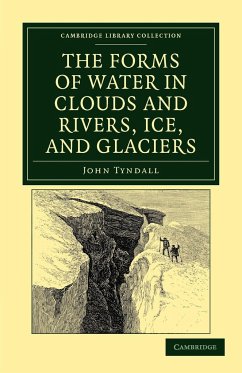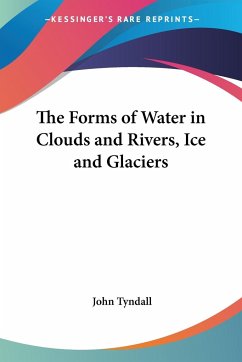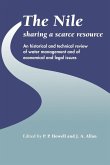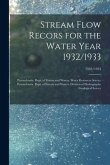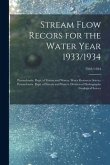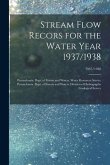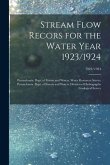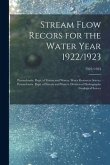John Tyndall
The Forms of Water in Clouds and Rivers, Ice, and Glaciers
John Tyndall
The Forms of Water in Clouds and Rivers, Ice, and Glaciers
- Broschiertes Buch
- Merkliste
- Auf die Merkliste
- Bewerten Bewerten
- Teilen
- Produkt teilen
- Produkterinnerung
- Produkterinnerung
A scientific account, published in 1872, of the earth's water system, written by a leading physicist and glacial scientist.
Andere Kunden interessierten sich auch für
![The Forms of Water in Clouds and Rivers, Ice and Glaciers The Forms of Water in Clouds and Rivers, Ice and Glaciers]() John TyndallThe Forms of Water in Clouds and Rivers, Ice and Glaciers18,99 €
John TyndallThe Forms of Water in Clouds and Rivers, Ice and Glaciers18,99 €![The Nile The Nile]() The Nile47,99 €
The Nile47,99 €![Stream Flow Recors for the Water Year 1932/1933; 1932/1933 Stream Flow Recors for the Water Year 1932/1933; 1932/1933]() Stream Flow Recors for the Water Year 1932/1933; 1932/193316,99 €
Stream Flow Recors for the Water Year 1932/1933; 1932/193316,99 €![Stream Flow Recors for the Water Year 1933/1934; 1933/1934 Stream Flow Recors for the Water Year 1933/1934; 1933/1934]() Stream Flow Recors for the Water Year 1933/1934; 1933/193417,99 €
Stream Flow Recors for the Water Year 1933/1934; 1933/193417,99 €![Stream Flow Recors for the Water Year 1937/1938; 1937/1938 Stream Flow Recors for the Water Year 1937/1938; 1937/1938]() Stream Flow Recors for the Water Year 1937/1938; 1937/193816,99 €
Stream Flow Recors for the Water Year 1937/1938; 1937/193816,99 €![Stream Flow Recors for the Water Year 1923/1924; 1923/1924 Stream Flow Recors for the Water Year 1923/1924; 1923/1924]() Stream Flow Recors for the Water Year 1923/1924; 1923/192418,99 €
Stream Flow Recors for the Water Year 1923/1924; 1923/192418,99 €![Stream Flow Recors for the Water Year 1922/1923; 1922/1923 Stream Flow Recors for the Water Year 1922/1923; 1922/1923]() Stream Flow Recors for the Water Year 1922/1923; 1922/192318,99 €
Stream Flow Recors for the Water Year 1922/1923; 1922/192318,99 €-
-
-
A scientific account, published in 1872, of the earth's water system, written by a leading physicist and glacial scientist.
Produktdetails
- Produktdetails
- Verlag: Cambridge University Press
- Seitenzahl: 206
- Erscheinungstermin: 19. September 2011
- Englisch
- Abmessung: 216mm x 140mm x 12mm
- Gewicht: 298g
- ISBN-13: 9781108037839
- ISBN-10: 1108037836
- Artikelnr.: 34448370
- Herstellerkennzeichnung
- Libri GmbH
- Europaallee 1
- 36244 Bad Hersfeld
- gpsr@libri.de
- Verlag: Cambridge University Press
- Seitenzahl: 206
- Erscheinungstermin: 19. September 2011
- Englisch
- Abmessung: 216mm x 140mm x 12mm
- Gewicht: 298g
- ISBN-13: 9781108037839
- ISBN-10: 1108037836
- Artikelnr.: 34448370
- Herstellerkennzeichnung
- Libri GmbH
- Europaallee 1
- 36244 Bad Hersfeld
- gpsr@libri.de
John Tyndall FRS was an important 19th-century Irish physicist. His scientific prominence developed in the 1850s as a result of his research into diamagnetism. Later, he produced discoveries in the fields of infrared radiation and air physical characteristics, establishing the link between atmospheric CO2 and what is now known as the greenhouse effect in 1859. Tyndall also authored over a dozen science books that introduced a large number of people to cutting-edge 19th-century experimental physics. From 1853 to 1887, he taught physics at the Royal Institution of Great Britain in London. He was elected to the American Philosophical Society in 1868. Tyndall was born at Leighlinbridge, Co. Carlow, Ireland. His father was a local police constable, descended from Gloucestershire emigrants who arrived in southeast Ireland around 1670. Tyndall attended the local schools (Ballinabranna Primary School) in County Carlow until his late teens and was most likely an assistant teacher near the conclusion of his tenure there. Technical drawing and mathematics were particularly important subjects in school, with some applications to land surveying. In his late teens, he was engaged as a draftsman by the Ordnance Survey of Ireland in 1839, and he later went to the Ordnance Survey of Great Britain in 1842.
1, 2. Clouds, rains, and rivers
3. The waves of light
4. The waves of heat which produce the vapour of our atmosphere and melt our glaciers
5. Experiments to prove the foregoing statements
6. Oceanic distillation
7. Tropical rains
8. Mountain condensers
9. Architecture of snow
10. Atomic poles
11. Architecture of lake ice
12. The source of the Aveiron
13. The Mer de Glace and its sources
14. Ice-cascade and snows of the Col du Géant
15. Questioning the glaciers
16. Branches and medial moraines of the Mer de Glace from the cleft station
17. The Talèfre and the Jardin
18. First questions regarding glacier motion
19. The motion of glaciers
20. Precise measurements of Agassiz and Forbes
21. The theodolite and its use
22. Motion of the Mer de Glace
23. Unequal motion of the two sides of the Mer de Glace
24. Suggestion of a new likeness of glacier motion to river motion
25. New law of glacier motion
26. Motion of axis of Mer de Glace
27. Motion of tributary glaciers
28. Motion of top and bottom of glacier
29. Lateral compression of a glacier
30. Longitudinal compression of a glacier
31. Sliding and flowing
32. Winter on the Mer de Glace
33. Winter motion of the Mer de Glace
34. Motion of the Grindelwald and Aletsch Glacier
35. Motion of Morteratsch Glacier
36. Birth of a crevasse
37. Icicles
38. The Bergschrund
39. Transverse crevasses
40. Marginal crevasses
41. Longitudinal crevasses
42. Crevasses in relation to curvature of glacier
43. Moraine-ridges, glacier tables, and sand cones
44. The glacier mills or moulins
45. The changes of volume of water by heat and cold
46. Consequences flowing from the foregoing properties of water, correction of errors
47. The molecular mechanism of water-congelation
48. The dirt bands of the Mer de Glace
49. Sea-ice and icebergs
50. The Aeggischhorn, the Märgelin See and its icebergs
51. The Bel Alp
52. The Riffelberg and Görner Glacier
53. Ancient glaciers of Switzerland
54. Erratic blocks
55. Ancient glaciers of England, Ireland, Scotland, and Wales
56. The glacier epoch
57. Glacial theories
58. Dilatation and sliding theories
59. Plastic theory
60. Viscous theory
61. Regelation theory
62. Cause of regelation
63. Faraday's view of regelation
64. The blue veins of glaciers
65. Relation of structure to pressure
66. Slate cleavage and glacier lamination
67. Conclusion.
3. The waves of light
4. The waves of heat which produce the vapour of our atmosphere and melt our glaciers
5. Experiments to prove the foregoing statements
6. Oceanic distillation
7. Tropical rains
8. Mountain condensers
9. Architecture of snow
10. Atomic poles
11. Architecture of lake ice
12. The source of the Aveiron
13. The Mer de Glace and its sources
14. Ice-cascade and snows of the Col du Géant
15. Questioning the glaciers
16. Branches and medial moraines of the Mer de Glace from the cleft station
17. The Talèfre and the Jardin
18. First questions regarding glacier motion
19. The motion of glaciers
20. Precise measurements of Agassiz and Forbes
21. The theodolite and its use
22. Motion of the Mer de Glace
23. Unequal motion of the two sides of the Mer de Glace
24. Suggestion of a new likeness of glacier motion to river motion
25. New law of glacier motion
26. Motion of axis of Mer de Glace
27. Motion of tributary glaciers
28. Motion of top and bottom of glacier
29. Lateral compression of a glacier
30. Longitudinal compression of a glacier
31. Sliding and flowing
32. Winter on the Mer de Glace
33. Winter motion of the Mer de Glace
34. Motion of the Grindelwald and Aletsch Glacier
35. Motion of Morteratsch Glacier
36. Birth of a crevasse
37. Icicles
38. The Bergschrund
39. Transverse crevasses
40. Marginal crevasses
41. Longitudinal crevasses
42. Crevasses in relation to curvature of glacier
43. Moraine-ridges, glacier tables, and sand cones
44. The glacier mills or moulins
45. The changes of volume of water by heat and cold
46. Consequences flowing from the foregoing properties of water, correction of errors
47. The molecular mechanism of water-congelation
48. The dirt bands of the Mer de Glace
49. Sea-ice and icebergs
50. The Aeggischhorn, the Märgelin See and its icebergs
51. The Bel Alp
52. The Riffelberg and Görner Glacier
53. Ancient glaciers of Switzerland
54. Erratic blocks
55. Ancient glaciers of England, Ireland, Scotland, and Wales
56. The glacier epoch
57. Glacial theories
58. Dilatation and sliding theories
59. Plastic theory
60. Viscous theory
61. Regelation theory
62. Cause of regelation
63. Faraday's view of regelation
64. The blue veins of glaciers
65. Relation of structure to pressure
66. Slate cleavage and glacier lamination
67. Conclusion.
1, 2. Clouds, rains, and rivers
3. The waves of light
4. The waves of heat which produce the vapour of our atmosphere and melt our glaciers
5. Experiments to prove the foregoing statements
6. Oceanic distillation
7. Tropical rains
8. Mountain condensers
9. Architecture of snow
10. Atomic poles
11. Architecture of lake ice
12. The source of the Aveiron
13. The Mer de Glace and its sources
14. Ice-cascade and snows of the Col du Géant
15. Questioning the glaciers
16. Branches and medial moraines of the Mer de Glace from the cleft station
17. The Talèfre and the Jardin
18. First questions regarding glacier motion
19. The motion of glaciers
20. Precise measurements of Agassiz and Forbes
21. The theodolite and its use
22. Motion of the Mer de Glace
23. Unequal motion of the two sides of the Mer de Glace
24. Suggestion of a new likeness of glacier motion to river motion
25. New law of glacier motion
26. Motion of axis of Mer de Glace
27. Motion of tributary glaciers
28. Motion of top and bottom of glacier
29. Lateral compression of a glacier
30. Longitudinal compression of a glacier
31. Sliding and flowing
32. Winter on the Mer de Glace
33. Winter motion of the Mer de Glace
34. Motion of the Grindelwald and Aletsch Glacier
35. Motion of Morteratsch Glacier
36. Birth of a crevasse
37. Icicles
38. The Bergschrund
39. Transverse crevasses
40. Marginal crevasses
41. Longitudinal crevasses
42. Crevasses in relation to curvature of glacier
43. Moraine-ridges, glacier tables, and sand cones
44. The glacier mills or moulins
45. The changes of volume of water by heat and cold
46. Consequences flowing from the foregoing properties of water, correction of errors
47. The molecular mechanism of water-congelation
48. The dirt bands of the Mer de Glace
49. Sea-ice and icebergs
50. The Aeggischhorn, the Märgelin See and its icebergs
51. The Bel Alp
52. The Riffelberg and Görner Glacier
53. Ancient glaciers of Switzerland
54. Erratic blocks
55. Ancient glaciers of England, Ireland, Scotland, and Wales
56. The glacier epoch
57. Glacial theories
58. Dilatation and sliding theories
59. Plastic theory
60. Viscous theory
61. Regelation theory
62. Cause of regelation
63. Faraday's view of regelation
64. The blue veins of glaciers
65. Relation of structure to pressure
66. Slate cleavage and glacier lamination
67. Conclusion.
3. The waves of light
4. The waves of heat which produce the vapour of our atmosphere and melt our glaciers
5. Experiments to prove the foregoing statements
6. Oceanic distillation
7. Tropical rains
8. Mountain condensers
9. Architecture of snow
10. Atomic poles
11. Architecture of lake ice
12. The source of the Aveiron
13. The Mer de Glace and its sources
14. Ice-cascade and snows of the Col du Géant
15. Questioning the glaciers
16. Branches and medial moraines of the Mer de Glace from the cleft station
17. The Talèfre and the Jardin
18. First questions regarding glacier motion
19. The motion of glaciers
20. Precise measurements of Agassiz and Forbes
21. The theodolite and its use
22. Motion of the Mer de Glace
23. Unequal motion of the two sides of the Mer de Glace
24. Suggestion of a new likeness of glacier motion to river motion
25. New law of glacier motion
26. Motion of axis of Mer de Glace
27. Motion of tributary glaciers
28. Motion of top and bottom of glacier
29. Lateral compression of a glacier
30. Longitudinal compression of a glacier
31. Sliding and flowing
32. Winter on the Mer de Glace
33. Winter motion of the Mer de Glace
34. Motion of the Grindelwald and Aletsch Glacier
35. Motion of Morteratsch Glacier
36. Birth of a crevasse
37. Icicles
38. The Bergschrund
39. Transverse crevasses
40. Marginal crevasses
41. Longitudinal crevasses
42. Crevasses in relation to curvature of glacier
43. Moraine-ridges, glacier tables, and sand cones
44. The glacier mills or moulins
45. The changes of volume of water by heat and cold
46. Consequences flowing from the foregoing properties of water, correction of errors
47. The molecular mechanism of water-congelation
48. The dirt bands of the Mer de Glace
49. Sea-ice and icebergs
50. The Aeggischhorn, the Märgelin See and its icebergs
51. The Bel Alp
52. The Riffelberg and Görner Glacier
53. Ancient glaciers of Switzerland
54. Erratic blocks
55. Ancient glaciers of England, Ireland, Scotland, and Wales
56. The glacier epoch
57. Glacial theories
58. Dilatation and sliding theories
59. Plastic theory
60. Viscous theory
61. Regelation theory
62. Cause of regelation
63. Faraday's view of regelation
64. The blue veins of glaciers
65. Relation of structure to pressure
66. Slate cleavage and glacier lamination
67. Conclusion.

